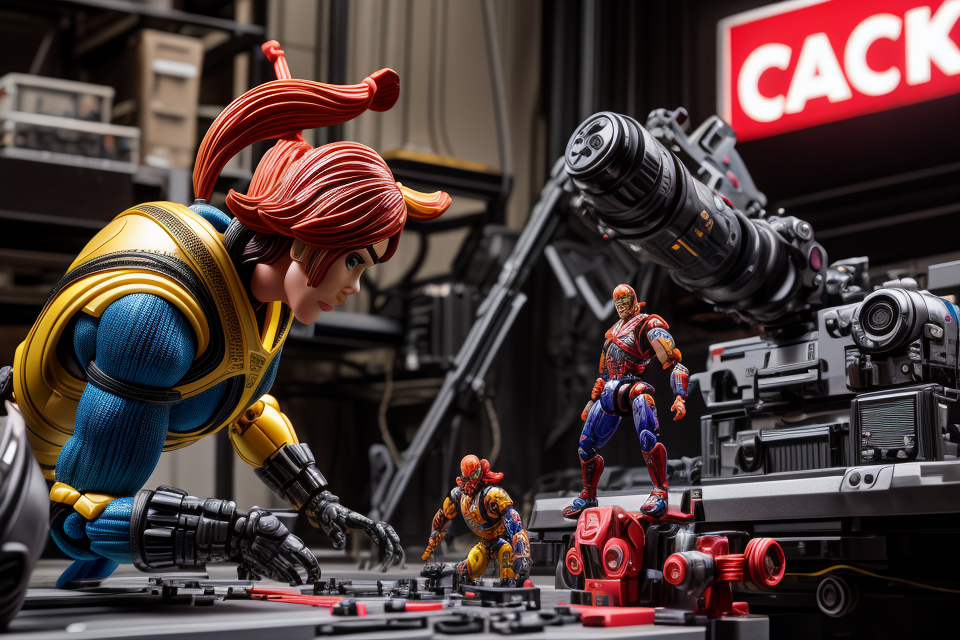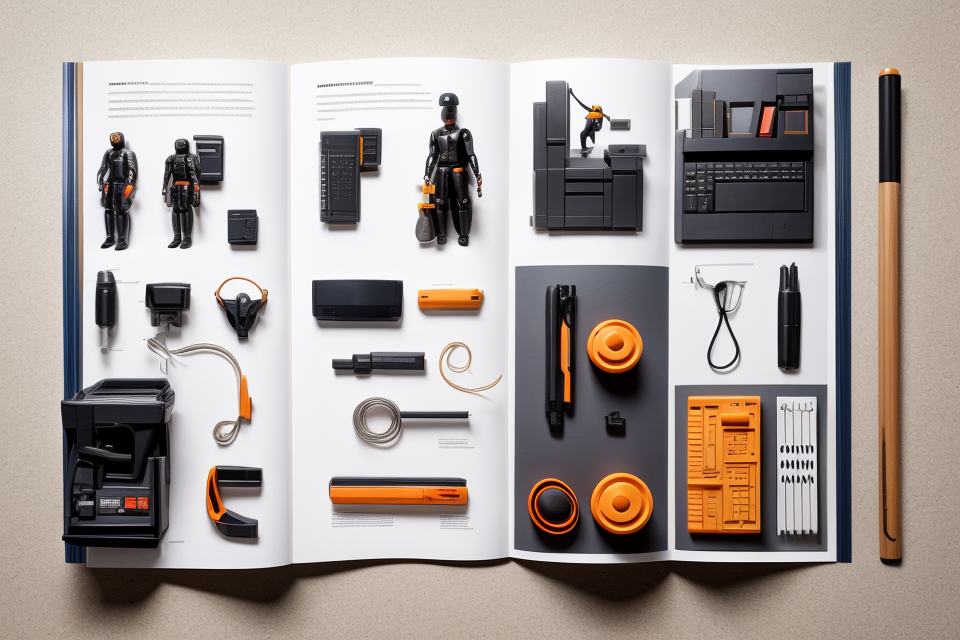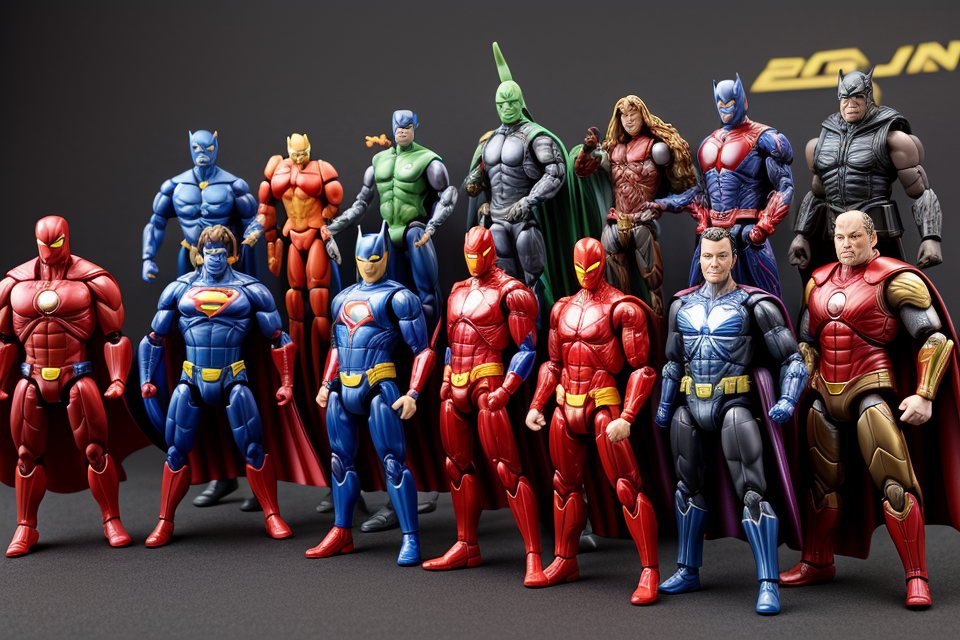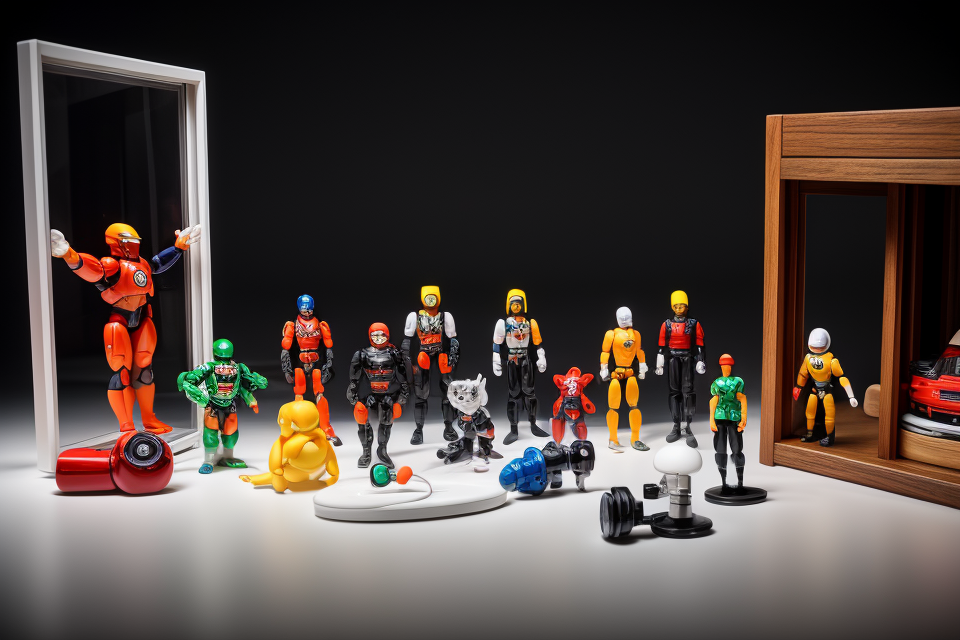
Action figures have been a beloved part of many childhoods for decades. These small, poseable figurines bring our favorite characters to life and inspire countless hours of imaginative play. But have you ever wondered how these little wonders are made? In this comprehensive guide, we’ll take a deep dive into the production process of action figures, from design to assembly. You’ll learn about the various materials and techniques used to create these iconic toys, and gain a new appreciation for the craftsmanship that goes into each and every action figure. So grab a chair, sit back, and let’s explore the world of action figure manufacturing!
The Design and Concept Phase
Developing the Concept
In the early stages of creating an action figure, the concept and design phase is crucial to its success. This phase involves a series of steps that are aimed at creating a unique and appealing character that will resonate with consumers. Here are some of the key steps involved in developing the concept for an action figure:
- Brainstorming Sessions: The first step in developing the concept for an action figure is to hold brainstorming sessions with the creative team. This includes writers, artists, designers, and other key stakeholders who will be involved in the production process. The goal of these sessions is to generate ideas and explore different concepts that can be used to create a unique and compelling character.
- Researching Popular Culture Trends: In order to create an action figure that will be successful, it’s important to stay up-to-date with the latest trends in popular culture. This includes looking at movies, TV shows, comic books, and other forms of media to see what characters and themes are currently popular. By incorporating these trends into the design of the action figure, it becomes more likely to appeal to consumers.
- Collaborating with Artists and Designers: Once the initial concepts have been developed, the next step is to collaborate with artists and designers to refine the design of the action figure. This involves working closely with sculptors, painters, and other specialists to ensure that the final product is visually appealing and meets the needs of consumers.
Overall, the concept phase is a critical part of the action figure production process. By exploring different ideas, staying up-to-date with popular culture trends, and collaborating with artists and designers, it’s possible to create a unique and compelling character that will be successful in the marketplace.
Creating the Prototype
When it comes to creating an action figure, the first step is to create a prototype. This prototype serves as a blueprint for the final product and helps to ensure that the action figure will be able to stand up to the rigors of play. There are several methods for creating a prototype, each with its own advantages and disadvantages.
3D Modeling Software
One of the most popular methods for creating a prototype is to use 3D modeling software. This software allows designers to create a digital model of the action figure, which can then be used to create a physical prototype. This method is fast and cost-effective, as it eliminates the need for manual sculpting and molding. However, it can be difficult to achieve the same level of detail and texture as with other methods.
3D Printing Technology
Another popular method for creating a prototype is to use 3D printing technology. This technology uses a computer-aided design (CAD) file to create a physical object. This method is similar to using 3D modeling software, but it allows for greater detail and texture. It is also faster and more cost-effective than traditional sculpting and molding methods.
Hand Sculpting and Molding
For those who want to achieve a more organic look, hand sculpting and molding is the way to go. This method involves sculpting the action figure by hand, using clay or other materials. Once the sculpt is complete, a mold is made of the figure, which is then used to create the final product. This method allows for the greatest level of detail and texture, but it is also the most time-consuming and expensive.
No matter which method is used to create the prototype, it is important to ensure that the action figure is able to stand up to the rigors of play. This means that the figure must be able to withstand being handled roughly, as well as being exposed to heat, cold, and other environmental factors. By creating a strong and durable prototype, designers can ensure that their action figures will be able to provide hours of fun for children and collectors alike.
The Manufacturing Process
Material Selection
When it comes to making action figures, the choice of materials plays a crucial role in determining the overall quality and durability of the final product. The following are some of the most commonly used materials in the production of action figures:
- Plastic: Plastic is one of the most commonly used materials in the production of action figures. It is affordable, lightweight, and can be easily molded into a wide range of shapes and sizes. Some of the most popular types of plastic used in action figure production include polyvinyl chloride (PVC), polyethylene (PE), and polypropylene (PP).
- PVC: PVC is a versatile plastic that is commonly used in the production of action figures due to its durability and flexibility. It can be easily molded into complex shapes and is resistant to wear and tear, making it an ideal material for action figures that will be handled frequently.
- POM: POM, or polyoxymethylene, is a type of plastic that is known for its high strength and durability. It is often used in the production of action figures that require a lot of articulation, as it can withstand the stress and pressure of moving parts.
- Die-cast metals: While most action figures are made from plastic, some high-end figures are made from die-cast metals. This type of manufacturing process involves casting the figure in a metal alloy, such as zinc or aluminum, to create a more durable and heavy-duty action figure. Die-cast metal figures are often more expensive than their plastic counterparts, but they are also more resistant to wear and tear and can withstand more frequent play.
Injection Molding
Injection molding is a manufacturing process that is commonly used to produce action figures. The process involves melting and mixing materials, injecting molten material into molds, cooling and solidifying, and trimming and inspection.
Melting and Mixing Materials
The first step in the injection molding process is to melt and mix the materials that will be used to create the action figure. The materials used can vary depending on the type of action figure being produced. For example, action figures made from plastic may be molded from polyethylene, polypropylene, or other types of thermoplastic polymers. The materials are melted in a heating chamber, often using a screw-type auger, which mixes the materials thoroughly.
Injecting Molten Material into Molds
Once the materials have been melted and mixed, they are injected into molds using high-pressure machines. The molds are typically made of metal or another material that can withstand the high temperatures and pressures involved in the injection molding process. The molten material is injected into the mold cavity, where it cools and solidifies.
Cooling and Solidifying
After the molten material has been injected into the mold, it is allowed to cool and solidify. The time required for the material to cool and solidify depends on the type of material being used and the size of the mold. During this process, the material contracts and shrinks slightly, which can create stress points and defects in the finished product.
Trimming and Inspection
Once the material has solidified, the action figure is removed from the mold and trimmed to the desired size and shape. The trimming process involves cutting away excess material and smoothing out any rough edges. The finished action figure is then inspected for defects, such as air bubbles, stress cracks, or other imperfections. Any defects that are found are typically repaired or the action figure is discarded.
Overall, injection molding is a complex and precise process that requires careful attention to detail to produce high-quality action figures. The process involves melting and mixing materials, injecting molten material into molds, cooling and solidifying, and trimming and inspection.
Painting and Decoration
The painting and decoration stage of action figure production is a crucial step in bringing the toy to life. It involves applying colors and designs to the figure to create a realistic and visually appealing appearance. There are several methods used in this stage, including hand painting, automated painting machines, and applying decals and stickers.
Hand Painting
Hand painting is a traditional method of painting action figures that has been used for decades. It involves painting each figure individually by hand, with the artist using a brush to apply the colors. This method allows for a high degree of detail and precision, and can create a unique, handcrafted appearance. However, it is also time-consuming and labor-intensive, making it less cost-effective for large-scale production.
Automated Painting Machines
In recent years, automated painting machines have become more prevalent in action figure production. These machines use a variety of techniques, such as airbrushing and spray painting, to apply the colors to the figure quickly and efficiently. While they can produce a consistent finish, they may not be able to replicate the level of detail and nuance that hand painting can achieve.
Applying Decals and Stickers
Another method of decorating action figures is by applying decals and stickers. Decals are pre-printed designs that are applied to the figure, while stickers are individual pieces of material that are applied to the figure and then covered with a clear coat to protect them. This method is often used for mass-produced action figures, as it is fast and cost-effective. However, it may not be as durable or visually appealing as hand painting or automated painting.
In conclusion, the painting and decoration stage of action figure production is a crucial step in creating a visually appealing and realistic appearance. While hand painting and automated painting machines both have their advantages and disadvantages, applying decals and stickers is a fast and cost-effective method for mass-produced action figures.
Assembly
The assembly process is a critical step in the production of action figures. It involves bringing together all the different parts of the figure, such as the head, body, arms, and legs, to create a complete toy. There are several methods used to assemble action figures, each with its own advantages and disadvantages.
Snap-fit Joints
Snap-fit joints are the most common method of assembly for action figures. These joints are designed to be easily snapped together, making it simple for children to play with the toys without having to worry about them falling apart. Snap-fit joints are usually made from plastic and are designed to be strong enough to withstand the rigors of play, yet flexible enough to allow for a wide range of poses and movements.
Adhesives and Glues
Another method of assembly used in the production of action figures is the use of adhesives and glues. These materials are applied to the different parts of the figure to hold them together. Adhesives and glues are typically used when the figure has more intricate or delicate parts that may not be suitable for snap-fit joints. The use of adhesives and glues can make the assembly process more time-consuming, as the parts must be carefully aligned and held in place until the glue dries.
Quality Control Checks
Once the assembly process is complete, the action figures undergo a series of quality control checks to ensure that they meet the required standards. These checks may include inspecting the figure for any defects or damage, checking the joints for proper movement, and ensuring that the paint and decals are applied correctly. Any issues that are identified during the quality control checks are addressed before the figure is packaged and shipped to retailers.
Overall, the assembly process is a critical step in the production of action figures. It requires careful attention to detail and a focus on producing high-quality toys that meet the needs and expectations of consumers. Whether using snap-fit joints, adhesives and glues, or a combination of both, the assembly process is an essential part of the production process that ensures that action figures are able to stand up to the rigors of play and provide hours of fun for children of all ages.
The Packaging and Distribution Phase
Carded Packaging
Blister Packs
Blister packs are a common form of carded packaging for action figures. They consist of a plastic tray with a clear plastic cover that protects the figure from dust and debris. The figure is secured to the tray with a series of tabs and clips, which also serve to hold the figure in place during shipping and handling. The blister pack is then covered with a paper or plastic sleeve that features artwork or other design elements related to the figure or franchise.
Window Boxes
Window boxes are another popular form of carded packaging for action figures. They feature a large window on the front that allows consumers to see the figure inside. The figure is typically displayed in a dynamic pose, and the window box is designed to showcase the figure’s articulation and accessories. The window box is usually made of thick cardboard or corrugated plastic, and is designed to be sturdy enough to withstand the rigors of shipping and handling.
Hangers and Display Stands
Some action figures come with hangers or display stands that allow consumers to display the figure in a more dynamic pose. These accessories are typically made of plastic and are designed to be attached to the figure’s foot or other stable point. The hanger or display stand allows the figure to be positioned in a way that highlights its articulation and accessories, and can make for a more visually striking display.
Overall, carded packaging is a crucial aspect of the action figure production process. It serves not only to protect the figure during shipping and handling, but also to showcase the figure’s design and features to consumers. By carefully considering the design and functionality of the carded packaging, toy manufacturers can help ensure that their action figures stand out on store shelves and appeal to collectors and fans alike.
Loose Figures
When it comes to packaging and distributing action figures, there are two main options: loose figures and boxed sets. In this section, we will focus on loose figures and the packaging and distribution process for these types of figures.
- Bulk packaging
- Loose figures are often packaged in bulk, with multiple figures packed into a single box or container. This type of packaging is typically used when the figures are being shipped to retailers or distributors, rather than to individual customers.
- Bulk packaging is typically done using corrugated cardboard boxes, which provide excellent protection against impacts and vibrations. The figures are placed in the box and then cushioned with bubble wrap or other packaging materials to prevent them from moving around and getting damaged during transport.
- Mailers and bubble wrap
- Another common method of packaging loose figures is using mailers and bubble wrap. In this method, the figures are individually wrapped in bubble wrap to protect them from damage, and then placed in a mailer or envelope for shipping.
- Mailers are typically made of thick cardboard or plastic, and are designed to be sturdy enough to protect the figures during shipping. They are often printed with the company’s logo or branding, and may include a return address or other information.
- Bubble wrap is a popular choice for packaging action figures because it provides excellent protection against impacts and vibrations. The air-filled bubbles cushion the figures and prevent them from moving around during transport.
Overall, the packaging and distribution process for loose figures is designed to ensure that the figures arrive at their destination in perfect condition. Whether they are packaged in bulk or individually, the figures are carefully protected to prevent damage during transport.
Shipping and Distribution
When it comes to shipping and distributing action figures, there are several key factors to consider. Here are some of the most important aspects of this process:
- Palletized shipments: Action figures are often shipped in large quantities on pallets, which makes it easier to transport them and keeps them secure during transit. These pallets are typically loaded onto trucks or other transportation vehicles and shipped to warehouses or retail stores.
- Warehousing and inventory management: Once the action figures arrive at their destination, they are typically stored in warehouses until they are ready to be sold. This requires careful inventory management to ensure that the right products are in the right place at the right time.
- International shipping and customs clearance: If the action figures are being shipped to other countries, there may be additional considerations to take into account. For example, customs clearance may be required, and there may be specific regulations or requirements that must be followed to ensure that the products are legally imported and exported.
Overall, the shipping and distribution phase of action figure production is a complex process that requires careful planning and coordination to ensure that the products are delivered to the right places at the right times. By following best practices and working with experienced partners, manufacturers can ensure that their action figures are shipped and distributed efficiently and effectively.
The Evolution of Action Figure Production
From Hand-Sculpted to Mass-Produced
The production of action figures has come a long way since the early days of hand-sculpted models. Today, the process of creating mass-produced action figures involves a complex network of technologies, manufacturing processes, and global supply chains.
- The rise of mass-produced action figures
In the 1960s, the popularity of action figures exploded with the release of the first mass-produced action figure – the 12-inch tall, muscular, and highly articulated “Action Man” doll. This new breed of toy quickly became a cultural phenomenon, inspiring countless children to engage in imaginative play and fueling the growth of the toy industry.
- Advances in technology and manufacturing processes
Over the years, advances in technology and manufacturing processes have greatly expanded the capabilities of action figure production. For example, the introduction of injection molding in the 1950s revolutionized the process of creating plastic toys by allowing for mass production of highly detailed and consistent parts. Similarly, the advent of 3D printing has enabled manufacturers to produce complex and customized action figures with unprecedented speed and precision.
- The impact of globalization and outsourcing
The globalization of the toy industry has also played a significant role in the mass production of action figures. Many manufacturers now outsource their production to countries with lower labor costs and less stringent environmental regulations, allowing them to reduce costs and increase profits. While this has led to greater efficiency and affordability in the production of action figures, it has also raised concerns about labor practices and environmental impact.
Sustainability and Environmental Concerns
- In recent years, the production of action figures has become more environmentally conscious.
- Companies are taking steps to reduce waste and their carbon footprint throughout the production process.
- This includes using eco-friendly materials and packaging, as well as implementing ethical sourcing practices.
- Additionally, companies are being held accountable for their environmental impact through initiatives such as corporate social responsibility.
- As consumers become more aware of the environmental impact of their purchases, sustainability in action figure production is becoming increasingly important.
- Some companies are even using recycled materials in their products to further reduce their environmental impact.
- The goal is to create a more sustainable production process that minimizes waste and harm to the environment.
The Future of Action Figure Production
Customization and 3D printing
The future of action figure production is expected to see a significant shift towards customization and 3D printing. This technology will allow manufacturers to produce highly detailed and personalized action figures that are tailored to individual customers’ preferences. The use of 3D printing will also reduce waste and lower production costs, making it more accessible to consumers.
Virtual and augmented reality experiences
Another trend that is expected to shape the future of action figure production is the integration of virtual and augmented reality experiences. This technology will allow consumers to interact with their action figures in new and exciting ways, bringing them to life in a virtual world. Manufacturers can also use this technology to create more realistic and interactive packaging, enhancing the overall consumer experience.
The role of artificial intelligence and automation
Artificial intelligence and automation are also expected to play a significant role in the future of action figure production. These technologies will enable manufacturers to streamline their production processes, reducing costs and increasing efficiency. Additionally, AI can be used to analyze consumer data and preferences, allowing manufacturers to create more targeted and personalized action figures.
Overall, the future of action figure production looks bright, with new technologies and trends poised to transform the industry. As consumers become more demanding and discerning, manufacturers will need to adapt and innovate to meet their needs and stay ahead of the competition.
FAQs
1. What materials are used to make action figures?
Action figures are typically made from a variety of materials, including plastic, vinyl, and polyresin. The specific material used can depend on the intended design and function of the figure. For example, figures that need to be poseable may require more flexible materials, while those that are intended to be static displays may be made from more rigid materials. Some action figures may also include electronic components or other special features that require additional materials.
2. How are action figures designed?
Action figures are designed by a team of artists and designers who work together to create the overall look and feel of the figure. This process typically begins with concept art and sketches, which are then refined and finalized into a 3D digital model. The digital model is then used to create a mold, which is used to produce the final product.
3. What is the process for producing action figures?
The process for producing action figures typically involves several steps, including designing the figure, creating a mold, injecting the material into the mold, and finishing the figure. The exact process can vary depending on the materials and equipment used, but the general steps are typically the same. Once the figure is produced, it may undergo additional processing, such as painting or applying decals, to add color and detail.
4. How are action figures packaged and sold?
Action figures are typically packaged in blister packs or boxes, which are designed to protect the figure during shipping and storage. The packaging may include information about the figure, such as its name and character, as well as artwork or other visual elements that help to market the product. Action figures are typically sold through a variety of retail channels, including toy stores, comic book shops, and online marketplaces.
5. How long does it take to produce an action figure?
The time it takes to produce an action figure can vary depending on a number of factors, including the complexity of the design, the materials used, and the size of the production run. In general, however, the process of producing an action figure can take several months, from the initial design and development stages to the final production and packaging. This timeline can be longer for more complex figures or for smaller production runs.


